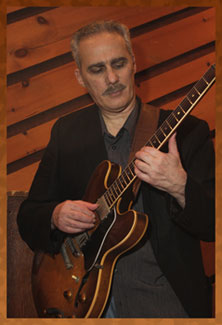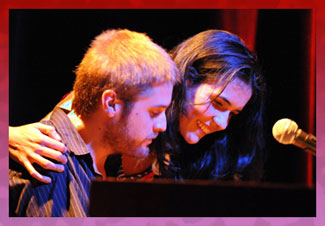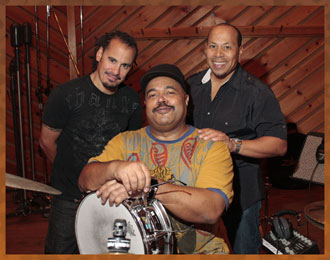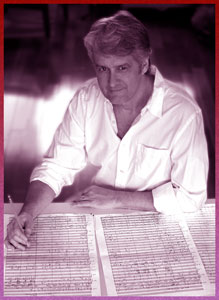

|
Soundclip:
|
| See Steve's Hand-Written Lead
Sheet |
|
Steve
Khan's
lead
sheet:  But, this is what can happen when you simply follow your instincts, and see where they will lead you. But, this is what can happen when you simply follow your instincts, and see where they will lead you.From playing the Intro section, over and over again, by myself, I could already tell that the tune was going to be another cha-cha-cha. But letter [I] contains one of rhythmic oddity, which I know takes the tune out of clave - usually a mortal sin! I tried a number of ways to remedy the fact that an odd numbered bar was present by my musical instincts, that bar is bar 3. However, I just felt that, after openly acknowledging that fact, Marc Quiñones and Bobby Allende would just find a way to deal with it, and not bust my balls about it - at least not too much!!! I hope that, by now, they have forgiven me for this transgression. Fortunately, once we have arrived at [A] everything normalizes, at least until [I] returns for a reprise, just before all the percussion fireworks. I suppose that this piece has more of its rhythmic and harmonic roots in the world of R&B, more than in the Latin idiom, or Jazz, for that matter. And, like much of the material that Eyewitness has always chosen to play, the piece wanders and drifts into differing moods and attitudes. From a guitar perspective, with the absence of another chordal instrument or linear instrument(saxophone; trumpet; or trombone, for example), one has to dance between the two functions. So, when I was composing the [A] and [B] sections, it seemed like the best possible solution was to have the first 2 bars playing chordal groove and then, this would be answered by 2 bars containing a melodic line. In essence, the chord movement is an extended reflection of what takes place in letter [I]. In bars 13-15 of [A], when the Abmaj7#4 chord appears, after having heard it many times by itself, I decided to take a small risk and ask Rob Mounsey if he could just color in those bars with a string tremolo. My hope was that, for a brief moment, that kind of orchestration device would bring a sense of mystery to everything. But, in truth, those bars came to represent something else for me, something a bit more sentimental, harkening back to my earliest days in New York. I always remember that, during the early '70s here in New York, each time I jammed or played with Mike Brecker, and when any major 7#4 chord would appear in any tune, we would look at one another, and Mike would then launch into one of his various Joe Henderson tenor sax impressions, born of his immense respect for Joe's Blue Note recordings. These 'impressions' - probably came from hearing the album "MODE FOR JOE" or, his playing on Larry Young's "UNITY" album - never failed to make me smile and laugh. Now, when I hear these very brief Lydian moments during this tune, I get that same feeling, and that warm and familiar smile just reappears. It's kind of a funny way to reference a dear, dear friend, but, in life we all have these kinds of triggers for great memories. I have already spoken about the demos that had to be made for this recording, and out of respect for Rob, I wrote out the bass parts so there would not be too much for him to think about. However, when it came time to actually begin to play the music, I never ever expected that Anthony Jackson would actually play so many of these same bass parts so faithfully. They were always only intended to be a guide and nothing more. It becomes especially eyebrow-raising for me when I began to listen back to [D], the guitar solo, and heard all these basslines being played with such accuracy. I certainly didn't expect that, and I was certain that our normal conversational style of playing would take over. But, that's not the way that it went down, at least not on that particular day. Letter [B] is also constructed as a call & response idea, and offers some traditional cha-cha rhythms, but here with touches of the blues or R&B. I am always reminded that the great Herbie Hancock, no matter what kind of piece he might be playing, he never loses touch with his blues, R&B, and gospel roots. Those elements always come to the surface somewhere. So, this section has a bit of that flavor, in addition to elements that are clearly from the Latin genre. As the tune moves forward, [I2] offers a brief reprise of our Intro. When I had written the portion that became letter [C], I realized that the movement of the top note of the guitar voicings would not be enough to carry the full melodic weight of the section. I then composed, what some would refer to as, a "real" melody line to be sung by a vocalist. Of course, my initial thought was that Manolo Badrena would sing the part.  At that same moment, I also thought that, perhaps, this could be the moment when I should try to realize another musical fantasy of mine, and that was to see if I could somehow get the wonderful Gracinha Leporace, who is the wife of Sergio Méndes, and really the voice of essentially all of his music, to sing the vocalese sections on at least one of the tunes. But despite my most ardent and sincere efforts, I just could not get this to happen. In truth, it was such a great disappointment. At that same moment, I also thought that, perhaps, this could be the moment when I should try to realize another musical fantasy of mine, and that was to see if I could somehow get the wonderful Gracinha Leporace, who is the wife of Sergio Méndes, and really the voice of essentially all of his music, to sing the vocalese sections on at least one of the tunes. But despite my most ardent and sincere efforts, I just could not get this to happen. In truth, it was such a great disappointment.However, in a parallel universe, something else was brewing, and something that would become equally as beautiful and rewarding. Thanks to yet another miracle of the Internet Age, I had become friends with Andrés Beeuwsaert, who plays piano and sings as part of Argentina's wonderful Aca Seca Trio. The more that I listened to the vocalese section of this piece, I thought that maybe Andrés would be a great choice for someone to sing it. So, via e-mail, he and I discussed this idea, and I sent him an mp3 of the original demo. After listening, he wrote me that he would love to participate, and that he wanted to have his "novia" - Tatiana Parra, a superb singer from Brasil, sing the part as well. Knowing her music and singing style too, I thought that this would be wonderful. How much luckier could I possibly be? And so, they sang to a rough mix, and then sent me their tracks via the wonders of the Web. Simply put, it was such a great honor for me, and an extreme musical pleasure, to have their voices and spirit present on this recording. To state the obvious, of course, they sound so wonderful together singing these sections! From a harmonic perspective, the chordal movements in [C] represent some of the nicest writing on the recording. There is a mixture of the sense of the top voice being consistent and the bass notes moving around. It is an old device, but always effective. The melody here is really very blues-based, simple, and that is what makes the section work so well. Like "María Mulambo" this tune is also another adventure into the world of the extended song form. I don't know that Andrés and Tati envisioned themselves as part of some 10-minute epic, with long drum and percussion solos at the end, but that's what the piece became. In truth, when I was laying out the format for the tune, I had always envisioned the ending, letter [F]-[F2], as a long drum solo for Dennis Chambers - but, at the last moment, at the recording session, Bobby Allende suggested that the solo section might be better served if the solos alternated between Dennis; Marc and Bobby. And so, as an exercise in my ongoing maturation process, which must include greater flexibility, I went along with this concept, and that is what you now hear. I have to admit that, in the end, it was a great idea. I have already mentioned one earlier orchestration touch by Rob Mounsey, but I asked him to add some sustained string voices under the drum and percussion solos.  In the broader traditions of Latin music, most times the rhythm section is enhanced and punctuated by the sounds of a brass section, usually trumpets and trombones. But, in contrast to the crisp and aggressive nature of Latin percussion, I have always liked the feeling provided by instruments with more sustain. This way there is a sense of romance, coupled with the fire of all the dance rhythms. So, during the percussion solos, as the harmonic movement constantly shifts amidst a mysterious guitar guajeo, I had Rob accentuate the movement in the lowest voice with great subtlety as the sections moved along. He did this beautifully, starting out very simply, and then adding a voice each time the sections progressed. It's wonderful to hear Dennis, Marc and Bobby add intensity and density to their solos with each go 'round. "Influence Peddler" fades out during Dennis last 16-bar section. As you hear him blasting away, one can only imagine what might have followed, and this is when a fade is at its most effective. In the broader traditions of Latin music, most times the rhythm section is enhanced and punctuated by the sounds of a brass section, usually trumpets and trombones. But, in contrast to the crisp and aggressive nature of Latin percussion, I have always liked the feeling provided by instruments with more sustain. This way there is a sense of romance, coupled with the fire of all the dance rhythms. So, during the percussion solos, as the harmonic movement constantly shifts amidst a mysterious guitar guajeo, I had Rob accentuate the movement in the lowest voice with great subtlety as the sections moved along. He did this beautifully, starting out very simply, and then adding a voice each time the sections progressed. It's wonderful to hear Dennis, Marc and Bobby add intensity and density to their solos with each go 'round. "Influence Peddler" fades out during Dennis last 16-bar section. As you hear him blasting away, one can only imagine what might have followed, and this is when a fade is at its most effective.As I was reviewing the actual written music for the lead sheet, as it is presented here, I realized that it was strange that I hadn't written out the bass part for [F]-[F2] on my own lead sheet, which is what you are seeing. The reason was that, I had written out a specific bass part for Anthony, and really did not need to see that for the ending on my part. In general, when a piece of music, using real full-size sheet music paper, has to be laid out over two music stands, it's best not to have it extend past 5 pages. So, if I had included Anthony's bass part on my own mini-score, it would have become 6 pages long, and that would have been tedious for me. So, as I do receive lots of nice messages and e-mails from Anthony Jackson fans, I wanted to make certain that they could access his bass part for the Fade. So, you can see it as Pg. 6 here, and the only link to it can be found at Pg. 5. Sometimes, when I now listen to the [F] sections, I wonder if I should have gone the extra mile in the area of production values and re-played the guitar part on my ESP Strat. There is no doubt that the edgier, funkier quality of any Strat would have given this kind of part a better sonic fit, in context. But, in the end, I just didn't want to go that far towards turning the recording into a BIG production. While we are on the subject of production, and production values, I think that it is worth discussing just how much overall care went into all the mixes for "PARTING SHOT." When James Farber and I gathered together again at Avatar's Studio 'C' to mix the recording, I had, as I almost always do, budgeted 2 days for mixing, with a 3rd day held in reserve, in case, I was unhappy with a mix or two. We could then go back in, recall that mix and hopefully get it closer to being right. As it turned out, James and I would end-up recalling 9 of the 10 mixes! I can't ever remember having to do that before. In my experience, which is not exactly vast in the production of Latin music, the most common error committed, when it comes to mixing, is in representing the conga properly.  By non-Latinos, the conga is often not perceived as what it really is, and that is that, the conga is the heartbeat of the music! So, I try to be really, really careful in just how we are presenting, in this case, the sound of Bobby Allende on this recording. Anyone who is, by now, familiar with the recording knows that the panning of the instruments is completely consistent throughout, and Bobby's congas appear on the right side. By non-Latinos, the conga is often not perceived as what it really is, and that is that, the conga is the heartbeat of the music! So, I try to be really, really careful in just how we are presenting, in this case, the sound of Bobby Allende on this recording. Anyone who is, by now, familiar with the recording knows that the panning of the instruments is completely consistent throughout, and Bobby's congas appear on the right side.What became remarkable to me, to my ears, as James and I went along in the mixing process, was just how easily the conga could be obscured or masked by my guitar sound alone! Especially during dense chordal passages, it was as if the conga suddenly became hidden when James and I had done nothing differently. It is always remarkable to me that people's perceptions of the guitar, and its sound and range, are so way off. The guitar is really a very low sounding instrument. When you add in with all this that, Anthony's deep and rich bass tones are there too, and then you have Dennis Chambers' snare and tom-toms? Well, it is hard for the conga to fight through all of that. So, placing the congas on the right side gives them, at the very least, their own sonic space. One of the oddities, on this tune, during the break bars that precede letter [C], when the conga is essentially alone, the perception can be that James gave them a ride(raised their level a touch), but nothing could be further than the truth. James really believes in setting a level for an instrument, and allowing the player's dynamics to speak. It's as simple as that. But, this shows you how much the guitar, bass and drums serve to, at times, obscure the conga. So, knowing all this, what possible reason was there for the recalls of virtually ALL the mixes? The truth is that it really had to do with how we had been presenting Anthony Jackson's bass and Dennis Chambers' drums. Of course, while making adjustments to those instruments, we might have touched-up something else as well. But, the other touch-ups were really very minor. Anthony's performance on "Influence Peddler" is really a perfect example of why I felt that we had to bring out the bass more. After listening to the original mix, I remember discussing it with James and telling him that, "I can feel the bass, but I can't distinguish the pitches, the notes that he's playing." And so, when we really got inside of the bass performance here, it sounded to me as though Anthony had used his "palm mute" technique almost throughout, and that caused the sense of feeling a pulse, but not really hearing the notes. So, on this tune, every possible effort was made to bring out the notes!!! And this is what you now hear. Where the drums were concerned, the first mix just didn't capture Dennis' power in the ensemble sections. Of course, there were no problems during the [F]-[F2] sections while trading solos. Needless to say, to get the final result, it was worth all the extra trouble, expense, and stress, and James, Rick Kwan, our assistant engineer, and I worked extremely hard to achieve the best possible results. As I will continue to say, there are NO perfect mixes, but we gave it every possible bit of attention and care. About the title, "Influence Peddler"? Like "Change Agent" this was a political phrase that I happened to write down during the presidential campaign of 2008, and I put it on my list of potential song titles. Thanks to my dear friend, Felipe Díaz, I was able to once again present a subtitle in Spanish, "Traficante de Influencias." If one is doing a recording of Latin Jazz, it's nice to have Spanish subtitles for as many of the tunes as is possible.
[Photos: Steve Khan; Marc Quiñones-Dennis Chambers-Bobby Allende by Richard Laird
Andrées Beeuwsaert and Tatiana Parra taken at the Café Vinilo in Buenos Aires on March 13, 2011 by Anita Kalikies Photo: Rob Mounsey by Paul Mounsey] |